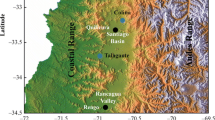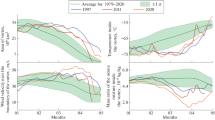Abstract
Lidar observations of aerosol and ozone, carried out at Siberian Lidar Station (SLS) of Institute of Atmospheric Optics, Siberian Branch, Russian Academy of Sciences in Tomsk (56°29′ N; 85°3′ E), showed the presence of stratospheric aerosol layers over Tomsk during winter 2017–2018, signs of descending air masses, and deficit of ozone. The Aura OMI/MLS observations indicated that in December-January 2017/2018 the northern Eurasia had been under the impact of Arctic air masses from the Eastern Hemisphere with deficient total ozone (TO) and NO2 contents in the stratosphere, and low temperature in the stratosphere. Analysis of back trajectories and MLS profile-integrated TO showed that due to dynamic disturbance of the Arctic stratosphere in December 2017, cold air masses with excessive reactive chlorine (in view of deficient NO2) were exported from within the Arctic circle to the stratosphere over Tomsk. Seemingly, in the Tomsk stratosphere, after being exposed to solar radiation and to the excessive reactive chlorine (in view of NO2 deficit), and, staying chemically isolated, they evolved into chemically disturbed state, similar in ozone destruction rate to the conditions of the springtime Arctic stratosphere. The correlations between deviations in water vapor and ozone mixing ratios and number concentrations are most strong for mixing ratios, for Eureka, Ny-Ålesund, Jokioinen, St. Petersburg, and Tomsk, and for December 2017 (versus January 2018).






Similar content being viewed by others
REFERENCES
Solomon, S., Stratospheric ozone depletion: A review of concepts and history, Rev. Geophys., 1999, vol. 37, no. 3, pp. 275–316. https://doi.org/10.1029/1999RG900008
Von Clarmann, T., Chlorine in the stratosphere, Atmosfera, 2013, vol. 26, no. 3, pp. 415–458.
Bazhenov, O.E., Increased humidity in the stratosphere as a possible factor of ozone destruction in the Arctic during the spring 2011 using Aura MLS observations, Int. J. Remote Sens., 2019, vol. 40, no. 9, pp. 3448–3460. https://doi.org/10.1080/01431161.2018.1547449
Jiang, Y., Yung, Y.L., and Zurek R.W., Decadal evolution of the Antarctic ozone hole, J. Geophys. Res., 1996, vol. 101, no. D4, pp. 8985–8999. https://doi.org/10.1029/96JD00063
Sanders, R.V., Solomon, S, Smith, J.P., Perliski, L., Miller, H.L., Mount, G.H., Keys, J.G., and Schmeltekoph, A.L., Visible and near-ultraviolet spectroscopy at McMurdo Station, Antarctica: 9. Observations of OClO from April to October 1991, J. Geophys. Res., 1993, vol. 98, no. D4, pp. 7219–7228. https://doi.org/10.1029/93JD00042
Solomon, S., Sanders, R.W., and Miller, H.L., Jr., Visible and near-ultraviolet spectroscopy at McMurdo Station, Antarctica 7. OClO diurnal photochemistry and implications for ozone destruction, J. Geophys. Res., 1990, vol. 95, no. D9, pp. 13,807–13,817. https://doi.org/10.1029/JD095iD09p13807
Bazhenov, O.E., Quasi-biennial oscillation of the total ozone and ozone concentrations at separate altitude levels over Arctic and Tomsk according to TOMS, OMI, and MLS observations, Int. J. Remote Sens., 2015, vol. 36, no. 12, pp. 3033–3040. https://doi.org/10.1080/01431161.2015.1055609
Rao, J., Ren, R., Chen, H., Yu, Y., and Zhou, Y., The stratospheric sudden warming event in February 2018 and its prediction by a climate system model, J. Geophys. Res., 2018, vol. 23, no. 123. https://doi.org/10.1029/2018JD028908
Charlton, A.J. and Polvani, L.M., A new look at stratospheric sudden warmings, Part I: Climatology and modeling benchmarks, J. Clim., 2007, vol. 20, no. 3, pp. 449–471. https://doi.org/10.1175/JCLI3996.1
Singleton, C.S., Randall, C.E., Chipperfield, M.P., Davies, S., Feng, W., Bevilacqua, R.M., Hoppel, K.W., Fromm, M.D., Manney, G.L., and Harvey, V.L., 2002–2003 Arctic ozone loss deduced from POAM III satellite observations and the SLIMCAT chemical transport model, Atmos. Chem. Phys., 2005. vol. 5, pp. 597–609. https://doi.org/10.5194/acp-5-597-2005
Flury, T., Hocke, K., Haefele, A., Kämpfer, N., and Lehmann, R., Ozone depletion, water vapor increase, and PSC generation at midlatitudes by the 2008 major stratospheric warming, J. Geophys. Res., 2009, vol. 114, no. D18302. https://doi.org/10.1029/2009JD011940
Manney, G.L., Lawrence, Z.D., Santee, M.L., Read, W.G., Livesey, N.J., Lambert, A., Froidevaux, L., Pumphrey, H.C., and Schwartz, M.J., A minor sudden stratospheric warming with a major impact: Transport and polar processing in the 2014/2015 Arctic winter, Geophys. Res. Lett., 2015, vol. 42, pp. 7808–7816. https://doi.org/10.1002/2015GL065864
Manney, G.L., Lawrence, Z.D., Santee, M.L., Livesey, N.J., Lambert, A., and Pitts, M.C., Polar processing in a split vortex: Arctic ozone loss in early winter 2012/2013, Atmos. Chem. Phys., 2015, vol. 15, pp. 5381–5403. https://doi.org/10.5194/acp-15-5381-2015
Manney, G.L. and Lawrence, Z.D., The major stratospheric final warming in 2016: dispersal of vortex air and termination of Arctic chemical ozone loss, Atmos. Chem. Phys., 2016, vol. 16, pp. 15371–15396. https://doi.org/10.5194/acp-16-15371-2016
Burlakov, V.D., Dolgii, S.I., and Nevzorov, A.V., Modification of the measuring complex at the Siberian Lidar Station, Atmos. Oceanic Opt., 2004, vol. 17, no. 10, pp. 756–762.
Funding
This work was supported by the State Order of Institute of Atmospheric Optics, Siberian Branch, Russian Academy of Sciences (in the part of obtaining the results of measurements) and grant of President of Russian Federation (grant no. MK-2040.2021.1.5 for support of young Russian scientists) (in part of processing and analyzing the results).
Author information
Authors and Affiliations
Corresponding author
About this article
Cite this article
Bazhenov, O.E., Nevzorov, A.A., Nevzorov, A.V. et al. Disturbance of the Stratosphere over Tomsk prior to the 2018 Major Sudden Stratospheric Warming: Effect of ClO Dimer Cycle. Opt. Mem. Neural Networks 30, 146–156 (2021). https://doi.org/10.3103/S1060992X21020065
Received:
Revised:
Accepted:
Published:
Issue Date:
DOI: https://doi.org/10.3103/S1060992X21020065




